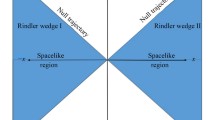Abstract
We investigate entanglement dynamics for two atoms coupling with fluctuating electromagnetic field in the cosmic string spacetime. We calculate the entanglement for different conditions. It is found that the entanglement behaviors are dependent on vacuum fluctuation, spacetime topology, two-atom separation and atomic polarization orientation. After a long time of evolution, entanglement would vanish, which means entanglement affected by electromagnetic fluctuation cannot maintain for a long time. For different spacetime topologies, entanglement presents different behaviors dependent on various parameters. When deficit angle parameter \(\nu =1\) and atom–string distance is toward infinity, the results in flat spacetime are recovered. When atoms keep close to the string, entanglement can be improved; specially, when two atoms locate on the string and have no polarization of axial direction, atoms are not affected by the electromagnetic fluctuation and entanglement can remain unchanged. When two-atom separation is relatively large, entanglement exhibits oscillation behavior as atom–string distance varies. This indicates that the existence of string profoundly modifies on the vacuum fluctuation and atom–field interaction. In addition, when two-atom separation is small, entanglement gains better improvement. Many parameters and conditions provide us with greater freedom to control the entanglement behaviors. In principle, this is useful to sense the cosmic string spacetime topology structure and property and discriminate different kinds of spacetime.





Similar content being viewed by others
References
Nilsen, M.A., Chuang, I.L.: Quantum Computation and Quantum Information. Cambridge University Press, Cambridge, UK (2000)
Horodecki, R., Horodecki, P., Horodecki, M., Horodecki, K.: Quantum entanglement. Rev. Mod. Phys. 81, 865 (2009)
Hu, J.W., Yu, H.W.: Entanglement dynamics for uniformly accelerated two-level atoms. Phys. Rev. A 91, 012327 (2015)
Yang, Y.Q., Hu, J.W., Yu, H.W.: Entanglement dynamics for uniformly accelerated two-level atoms coupled with electromagnetic vacuum fluctuations. Phys. Rev. A 94, 032337 (2016)
Hu, J.W., Yu, H.W.: Quantum entanglement generation in de Sitter spacetime. Phys. Rev. D 88, 104003 (2013)
Huang, Z.M., Tian, Z.H.: Dynamics of quantum entanglement in de Sitter spacetime and thermal Minkowski spacetime. Nucl. Phys. B 923, 458 (2017)
Copeland, E.J., Pogosian, L., Vachaspati, T.: Seeking string theory in the cosmos. Class. Quant. Grav. 28, 204009 (2011)
Hindmarsh, M.: Signals of inflationary models with cosmic strings. Prog. Theor. Phys. Suppl. 190, 197 (2011)
Vilenkin, A.: Cosmic strings as gravitational lenses. Astrophys. J. 282, L51 (1984)
Gott, J.R.: Gravitational lensing effects of vacuum strings-exact solutions. Astrophys. J. 288, 422 (1985)
Ford, L.H., Vilenkin, A.: A gravitational analogue of the Aharonov-Bohm effect. J. Phys. A Math. Gen. 14, 2353 (1981)
Bezerra, V.B.: Gravitational analogs of the Aharonov-Bohm effect. J. Math. Phys. 30, 2895 (1989)
Cai, H., Yu, H., Zhou, W.: Spontaneous excitation of a static atom in a thermal bath in cosmic string spacetime. Phys. Rev. D 92, 084062 (2015)
Zhou, W., Yu, H.: Spontaneous excitation of a uniformly accelerated atom in the cosmic string spacetime. Phys. Rev. D 93, 084028 (2016)
Cai, H., Ren, Z.: Radiative processes of two entangled atoms in cosmic string spacetime. Class. Quantum Grav. 35, 025016 (2018)
Bakke, K., Nascimento, J.R., Furtado, C.: Geometric phase for a neutral particle in the presence of a topological defect. Phys. Rev. D 78, 064012 (2008)
Cai, H., Ren, Z.: Geometric phase for a static two-level atom in cosmic string spacetime. Class. Quantum Grav. 35, 105014 (2018)
Bezerra de Mello, E.R., Saharian, A.A., Kh Grigoryan, A.: Casimir effect for parallel metallic plates in cosmic string spacetime. J. Phys. A Math. Theor. 45, 374011 (2012)
Huang, Z.M.: Quantum entanglement of nontrivial spacetime topology. Eur. Phys. J. C 80, 131 (2020)
He, P., et al.: Entanglement dynamics for static two-level atoms in cosmic string spacetime. Eur. Phys. J. C 80, 134 (2020)
Gorini, V., Kossakowski, A., Surdarshan, E.C.G.: Completely positive dynamical semigroups of N-level systems. J. Math. Phys. 17, 821 (1976)
Lindblad, G.: On the generators of quantum dynamical semigroups. Commun. Math. Phys. 48, 119 (1976)
Breuer, H.-P., Petruccione, F.: The Theory of Open Quantum Systems. Oxford University Press, Oxford (2002)
Wootters, W.K.: Entanglement of formation of an arbitrary state of two qubits. Phys. Rev. Lett. 80, 2245 (1998)
Andrews, G.E., Askey, R., Roy, R.: Special Functions. Cambridge University Press, Cambridge (1999)
Werner, R.F.: Quantum states with Einstein-Podolsky-Rosen correlations admitting a hidden-variable model. Phys. Rev. A 40, 4277 (1989)
Huang, Z.M.: Behaviors of quantum correlation for atoms coupled with fluctuating electromagnetic field with a perfectly reflecting boundary. Quantum Inf. Process. 18, 149 (2019)
Acknowledgements
This work is supported by the National Natural Science Foundation of China (61871205), the Guangdong Basic and Applied Basic Research Foundation (2021A1515012623, 2021A1515012138, 2019A1515011166) and the Project of Department of Education of Guangdong Province (2019KTSCX188, 2020KTSCX132).
Author information
Authors and Affiliations
Corresponding author
Additional information
Publisher's Note
Springer Nature remains neutral with regard to jurisdictional claims in published maps and institutional affiliations.
Rights and permissions
About this article
Cite this article
Huang, Z. Quantum entanglement for atoms coupling to fluctuating electromagnetic field in the cosmic string spacetime. Quantum Inf Process 20, 173 (2021). https://doi.org/10.1007/s11128-021-03119-8
Received:
Accepted:
Published:
DOI: https://doi.org/10.1007/s11128-021-03119-8



